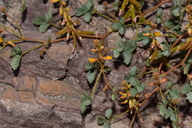Taxon Report
Hoffmannseggia peninsularis (Britton) WigginsBaja peninsula rushpea |
 © 2019 Joey Malone |
Taxon Summary
Hoffmannseggia peninsularis, commonly known as Baja peninsula rushpea, is a perennial shrub in the Fabaceae that is found in California and elsewhere. It occurs within Sonoran desert scrub, growing at elevations from 255 to 275 meters. Hoffmannseggia peninsularis is ranked 1B.1, Plants Rare, Threatened or Endangered in California and Elsewhere; Seriously threatened in California.Classification
|
Scientific Name: |
Hoffmannseggia peninsularis (Britton) Wiggins |
|
Common Name: |
Baja peninsula rushpea |
| Family: | Fabaceae |
| Element Code: | PDFAB20060 |
| USDA Plants Symbol: | |
|
Synonyms/Other Names: |
|
Ecology and Life History
| Lifeform: | perennial shrub |
| Blooming Period: Jan-Mar | Jan-Mar |
| Elevation: | 255-275 (835-900) |
| General Habitats: | Sonoran desert scrub |
| Microhabitat: | Gravelly, Metamorphic (sometimes), Rocky, Volcanic (sometimes) |
| Microhabitat Details: | In sparse vegetation on igneous/metamorphic bedrock slopes. |
Conservation Status
| CA Rare Plant Rank: | 1B.1 |
| Global Rank: | G2 |
|
State Rank: |
S1 |
| State List: | None |
| Fed List: | None |
| Other Status: | |
|
CRPR Changes: |
|
Occurrence Data from the CNDDB
| Total Occurrences: | 2 |
| Element Occurrence Ranks: | |
| Excellent (A) | 0 |
| Good (B) | 0 |
| Fair (C) | 0 |
| Poor (D) | 0 |
| None (X) | 0 |
| Unknown (U) | 2 |
| California Endemic: False | |
| California Counties and Islands: Name (Code) | |
| Imperial (IMP) | |
| Quads: Name (Quad Code) | |
| Tortuga (3311523) | |
Threat List Data from the CNDDB
| Threat List Total: | 0 | |
| EOs with Threat Listed: | Total EOs | % of EOs |
| 0 | % | |
|
|
||
Notes
|
Documented in California in the Chocolate Mtns. of IMP Co. in 2016 by A. Sanders. Not yet included in the Jepson eFlora. |
|
Threats: |
|
Potentially threatened by military activities, invasive plants, and small population size. |
|
Taxonomy: |
|
Similar to H. intricata and H. microphylla; differs in being nearly prostrate and having zig-zag branching, sticky, glandular trichomes on its young growth, and flowers 3–4 mm long (H. intricata is also not known from California). |
Selected References
| Proposed Addition to CRPR 1B.1 (2023) |
|
North American Flora, Volume 23 (5): 311 (1930) |
| Lundellia 2: 14–54 (1999) |
| Lundellia 9: 7–33 (2006) |
Citation
California Native Plant Society, Rare Plant Program. 2025. Rare Plant Inventory (online edition, v9.5.1). Website https://www.rareplants.cnps.org [accessed 29 December 2025].